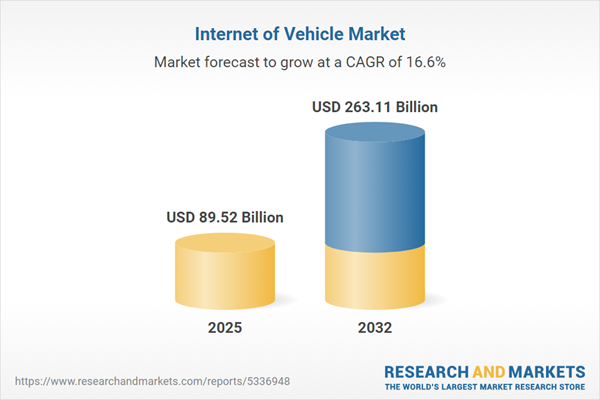Speak directly to the analyst to clarify any post sales queries you may have.
The Internet of Vehicle Market is transforming how enterprises manage transportation by integrating connected systems that optimize visibility, enable adaptive decision-making, and enhance compliance in today’s evolving regulatory landscape.
Market Snapshot: Growth Trends in the Internet of Vehicle Market
Senior decision-makers are encountering significant change in enterprise mobility as demand rises for integrated, intelligent fleet management. As of 2024, the Internet of Vehicle Market stands at USD 76.95 billion, with a projected increase to USD 89.52 billion by 2025. Long-range forecasts anticipate the market expanding further to USD 263.11 billion by 2032, presenting a robust compound annual growth rate (CAGR) of 16.61%. This growth derives from the accelerated adoption of artificial intelligence, digital platforms, and edge computing. Technology advances are facilitating faster operational decisions, streamlined supply chains, and adaptive mobility solutions, supported by analytic innovation and partnerships spanning multiple transportation sectors.
Scope & Segmentation of the Internet of Vehicle Market
This comprehensive report offers senior executives a structured overview of the market’s architecture, emphasizing critical segments and emerging technologies that drive industry evolution and competitive positioning.
- Hardware Components: Includes intelligent cameras, telematics, advanced sensors, GPS devices, and lidar systems. These tools strengthen fleet safety, generate actionable data, and boost operational productivity for both commercial and passenger vehicles.
- Software Components: Covers predictive analytics platforms, diagnostic tools, and remote-update solutions. These systems automate vehicle maintenance, oversight, and regulatory compliance, empowering organizations with large or distributed fleets to operate efficiently.
- Vehicle Types: Comprises commercial and passenger vehicles, each supported by customizable solutions. Enterprises benefit from performance optimization and the flexibility required to address varying service needs in dynamic transport environments.
- Communication Technologies: Encompasses 4G, 5G, and Dedicated Short Range Communications (DSRC). These technologies underpin secure, high-speed information exchange, enabling robust analytics and forming the backbone of connected vehicle ecosystems for modern transportation networks.
- Applications: Spans infotainment, diagnostics, navigation, traffic monitoring, and centralized fleet management. These applications equip enterprises with greater control and foster a more seamless mobility experience for stakeholders.
- Regions: Americas lead with investments in advanced infrastructure and connectivity. EMEA centers on compliance and sustainability, while the Asia-Pacific region drives adoption via proactive public policy and digital collaboration.
- Companies Covered: Key market actors include Huawei Technologies, Continental AG, Robert Bosch GmbH, DENSO Corporation, Qualcomm, Cisco Systems, NXP Semiconductors, Ericsson, Intel Corporation, and AT&T Inc., each contributing to technology progress and industry standards.
Key Takeaways for Senior Decision-Makers
- Real-time insights from integrated fleets help streamline resource allocation and support timely responses to shifting logistics needs.
- Edge computing capabilities enable continuous operation and flexibility, especially in regions with infrastructure challenges or widely dispersed assets.
- Advanced sensing technologies and high-performance connectivity facilitate greater supply chain adaptability and allow organizations to proactively manage operational risks linked to asset movement.
- Cybersecurity is now a primary consideration in technology investments, guiding organizations to implement robust protocols aligned to evolving privacy and compliance requirements.
- Regional dynamics, including infrastructure investment, regulatory direction, and multi-sector cooperation, are shaping strategic market entry decisions and resulting in differentiated deployment models.
Tariff Impact: Strategic Response Within Global Supply Chains
Forthcoming changes in U.S. tariffs for 2025 are prompting enterprises to reexamine their production and supplier frameworks. To remain agile, organizations in the Internet of Vehicle sector are consolidating manufacturing closer to core markets, expanding regional partnerships, and modifying software deployment models. These strategies help companies respond swiftly to regulatory adjustments and sustain effective operations globally.
Methodology & Data Sources
The research incorporates detailed interviews with senior industry leaders, targeted technical surveys, and consultation with regulatory bodies across major marketplaces. Findings have undergone independent benchmarking and validation, ensuring reliability for executive-level decision-making.
Why This Report Matters
- Offers actionable intelligence to facilitate the digital transformation and integration of connected vehicle technologies in enterprise operations.
- Prepares leadership teams to anticipate regulatory changes and enhance supply chain resilience amid diverse global compliance challenges.
- Empowers management with the insights needed to deploy scalable and future-proof connectivity solutions that support ongoing organizational growth.
Conclusion
This report equips senior executives with the clarity and strategic perspective needed to navigate connectivity-driven transformation in enterprise transportation and maintain resilient, high-performing mobility operations.
Additional Product Information:
- Purchase of this report includes 1 year online access with quarterly updates.
- This report can be updated on request. Please contact our Customer Experience team using the Ask a Question widget on our website.
Table of Contents
3. Executive Summary
4. Market Overview
7. Cumulative Impact of Artificial Intelligence 2025
Companies Mentioned
The companies profiled in this Internet of Vehicle market report include:- Huawei Technologies Co., Ltd.
- Continental AG
- Robert Bosch GmbH
- DENSO Corporation
- Qualcomm Incorporated
- Cisco Systems, Inc.
- NXP Semiconductors N.V.
- Telefonaktiebolaget LM Ericsson (publ)
- Intel Corporation
- AT&T Inc.
Table Information
| Report Attribute | Details |
|---|---|
| No. of Pages | 198 |
| Published | October 2025 |
| Forecast Period | 2025 - 2032 |
| Estimated Market Value ( USD | $ 89.52 Billion |
| Forecasted Market Value ( USD | $ 263.11 Billion |
| Compound Annual Growth Rate | 16.6% |
| Regions Covered | Global |
| No. of Companies Mentioned | 11 |









